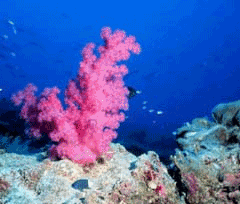Global Warming May Leed to Coral Reefs Grow

Coral reefs around the world could expand in size by up to a third in response to increased ocean warming and the greenhouse effect, according to Australian scientists. About 100,000 species living in and around coral reefs have so far been noted, although some scientists believe the real total may top 2 million. Currently 58 percent of the world's coral reefs are now endangered.
"Our analysis suggests that ocean warming will foster considerably faster future rates of coral reef growth that will eventually exceed pre-industrial rates by as much as 35 per cent by 2100," says Dr Ben McNeil, an oceanographer from the University of News South Wales. "Our finding stands in stark contrast to previous predictions that coral reef growth will suffer large, potentially catastrophic, decreases in the future," says McNeil, who led and published the research in the journal Geophysical Research Letters, with colleagues Dr Richard Matear of the Commonwealth Scientific and Industrial Research Organization (CSIRO) and Dr David Barnes from the Australian Institute of Marine Science, Townsville.
Previous research has predicted a decline of between 20 and 60 percent in the size of coral reefs by 2100 relative to pre-industrial levels due to increasing CO2 levels in ocean surface waters. The new research suggests that present coral reef calcification rates are not in decline and are equivalent to late 19th century levels.
Coral reefs are built from calcium carbonate when red algae cement together a framework of coral skeletons and sediments. They are generally found within 30N and 30S latitudes, because the reef-building corals are living in this waters. Reef-building corals are found mainly in the photic zone (<50m), where the sunlight reaches the ground and offers the corals enough energy. Seawater surface temperatures and the quantity of carbonate in seawater dictate their growth rate.
The Australian scientists have observed the calcification-temperature relationship at significant reef-building colonies around the world in the Indo-Pacific and at massive Porites reef colonies in Australia, Hawaii, Thailand, the Persian Gulf and New Ireland.
The predicted increase in the rate of coral reef calcification is most likely due to an enhancement in coral metabolism and/or increases in photosynthetic rates of red algae, according to the scientists. They used projections of ocean warming and CO2 concentration from a CSIRO climate model that accounts for atmosphere-ice and ocean carbon cycles.
"Our results show that increases in coral reef calcification associated with ocean warming outweigh decreases associated with increased atmospheric CO2", says CSIRO’s Dr Richard Matear. "While initially showing a decrease in calcification up to 1964, ocean warming outweighs the CO2 effect and stimulates recovery of coral reef calcification. Our results represent an average over the entire coral reef community and it will be important to undertake more specific regional analysis of models to better understand future changes in regions such as Australia’s Great Barrier Reef."
Dr David Barnes from the Australian Institute of Marine Science in Townsville says: "Coral reef calcification and the changes suggested in our research are separate to the adverse future effects of coral bleaching which is associated with the corals symbiotic micro-algae, and the significant impacts of human activities such as poor water quality, and unsustainable fishing on many of the worlds coral reefs."
















